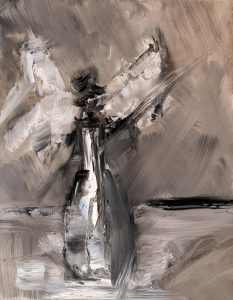21 Jan Daylight
 Despondency breaks off its course.
Despondency breaks off its course.
Anguish breaks off its course.
The vulture breaks off its flight.
The eager light streams out,
Even the ghosts take a draught.
And our paintings see daylight.
— Tomas Tranströmer
Painting is like a walk in the woods.
You set out full of hope with only a blank canvas. It’s bright and airy and meadowlike.
You pick up a brush and choose a woodpath.
Your first few marks feel promising and offer to become the armature upon which you’ll build a masterpiece.
But, quite soon, the path leads downhill—and into darkness.
None of your marks are making sense.
More paint doesn’t clarify, and erasures only make your murky and miserable painting murkier and more miserable.
You begin to suspect the armature; you begin to suspect the painter. They’re neither of them any good.
You chose the wrong path and now there’s no way out of the woods.
You make more strokes and more strokes and more, stabbing in the dark like a blinded creature.
You’re hopelessly lost. No compass will help you.
Then, all of a sudden, a mark makes sense; and then another and another and another.
Despondency breaks off its course.
The eager light streams out.
The painting sees the daylight.
Maybe not a masterpiece, but you’re out of the woods.
Above: Avenging Angel 1955. Oil on fiberboard. 8 x 10 inches.
